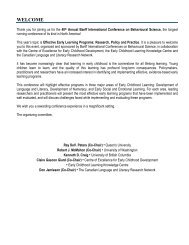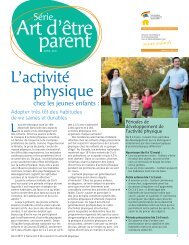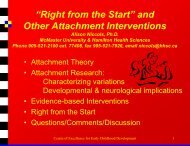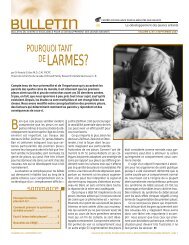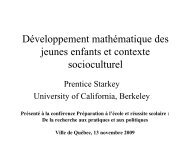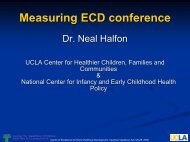Bulletin - The measure of excellence : Canadian early childhood ...
Bulletin - The measure of excellence : Canadian early childhood ...
Bulletin - The measure of excellence : Canadian early childhood ...
Create successful ePaper yourself
Turn your PDF publications into a flip-book with our unique Google optimized e-Paper software.
SPECIAL FEATURE ON RESEARCH: PREGNANCYDECISION-MAKING SWAYED BY WORDS USEDDoes the way in which informationis framed shape people's perceptionsand behaviour? Are we gettingthe same information when it isframed positively or negatively? A<strong>Canadian</strong> research team recentlydecided to test whether the framingeffect would alter a pregnantwoman's decision to use allergyrelateddrugs during her pregnancy.<strong>The</strong> team recruited women callersfrom the Motherisk Program, a counselingservice based in Toronto.Motherisk provides evidence-basedinformation about the risks associatedwith drug, chemical, radiation andinfectious exposures during pregnancy.Callers were randomly assigned toone <strong>of</strong> two groups. In one group,women were told that by taking anallergy-related drug there was a 1% to3% chance that a baby would be bornwith a major birth defect (negativeframing). In the second group, womenwere told that there was a 97% to 99%chance <strong>of</strong> having a healthy baby (positiveframing). Both groups were toldthat the allergy-related drug did notsignificantly increase the risk <strong>of</strong> birthdefects in the baby.When contacted a few days later,women who had received the positivelyframed information perceivedthe drug as less risky and were morelikely to say they would take it thanwere women who had been given thenegatively framed information. <strong>The</strong>researchers point out that theseresults concur with the findings <strong>of</strong> previousstudies on information framing."Framing is a very important issue,and here you have an important findingbecause it appears that negativeand positive framing may have a significantimpact on the decisions peoplemake" says Robin Walker, Pr<strong>of</strong>essor <strong>of</strong>Pediatrics at the University <strong>of</strong> Ottawaand Chief <strong>of</strong> Neonatology at theChildren's Hospital <strong>of</strong> Eastern Ontario.<strong>The</strong> study was well constructed,according to Walker. "It's an elegantpiece <strong>of</strong> work. <strong>The</strong>ir methodology wascarefully done. <strong>The</strong>y have two wellmatchedgroups and they came up witha significant result." However, JohnLeBlanc, Assistant Pr<strong>of</strong>essor <strong>of</strong>Pediatrics, Psychiatry, CommunityHealth and Epidemiology at DalhousieUniversity, points out that the groupswere not representative <strong>of</strong> the generalpopulation. "Mothers who callMotherisk are already concerned. Itwould be interesting to try this sameapproach with women at doctors'<strong>of</strong>fices or even women who don't getprenatal care."Both Walker and LeBlanc agreedthat the study's conclusions constitutea significant contribution to study inthis field.However,Walker stressed thatmore research is needed. "We need tolook more carefully at how we presentinformation and the impact <strong>of</strong> thatpresentation. This is a very broad issueand there is a need for more inquiry."Ref.: J. D. Jasper, R. Goel, A. Einarson,M. Gallo and G. Koren. "Effects <strong>of</strong>Framing on Teratogenic RiskPerception in Pregnant Women." <strong>The</strong>Lancet. Vol. 358. October 2001.PROBLEM PREGNANCIES AND INADEQUATE PARENTING<strong>The</strong> links between low socioeconomicbackground, inadequateparenting and criminal behaviourare now widely accepted and wellestablishedin research.However, links between problemswith pregnancy, delivery and adultcriminality have not been as easy toestablish as, to date, findings havebeen contradictory. Now a team <strong>of</strong><strong>Canadian</strong> and Swedish researchers hasexamined the role played by obstetriccomplications in the development <strong>of</strong>criminal and violent behaviour.<strong>The</strong> researchers studied 15,117individuals born in Stockholm,Sweden and monitored them untilage 30. Information on obstetric complications(which included problemsduring pregnancy, labour-deliveryand the neonatal period), criminalacts, the socioeconomic status <strong>of</strong> theirfamilies and inadequate parentingwas obtained from medical, health,social work and police records.Obstetrical complications alonewere not associated with adult criminality.However, obstetrical complicationscombined with inadequate parentingdid slightly increase the risk <strong>of</strong>criminal <strong>of</strong>fences among both menand women, and it more than doubledthe risk <strong>of</strong> committing violent<strong>of</strong>fences (i.e., crimes involving threatenedor perpetrated physical violencesuch as rape, assault or robbery)among men.A combination <strong>of</strong> obstetrical complicationsand inadequate parentingaffected only a small portion <strong>of</strong> thestudy subjects (3.1 % <strong>of</strong> the men and4.0% <strong>of</strong> the women). Inadequateparenting was experienced by 19.1%<strong>of</strong> the men and 18.1% <strong>of</strong> women and,as is frequently the case, was associatedwith an increased risk <strong>of</strong> <strong>of</strong>fending.For Darren Lezubski, ManagingDirector <strong>of</strong> the Centre <strong>of</strong> Excellence forChild and Youth-Centered PrairieCommunities in Winnipeg, the study"improves the methodology comparedto previous studies. <strong>The</strong> researcherscontrolled for possible confoundingfactors, such as mental retardation andmajor psychiatric disorders known toincrease the likelihood <strong>of</strong> <strong>of</strong>fending."<strong>The</strong> authors <strong>of</strong> the study also analyzedthe data by gender, "something that istoo <strong>of</strong>ten neglected in this kind <strong>of</strong>research, despite recognized differencesin the prevalence <strong>of</strong> criminalbehaviour by gender."Since the study suggests thatobstetrical complications may influencethe development <strong>of</strong> criminaland violent behaviour, we can wonder"what services can be <strong>of</strong>fered topregnant women to reduce the incidence<strong>of</strong> complications at birth?"adds Lezubski. Additionally, it wouldbe interesting to broaden the scope<strong>of</strong> environmental variables in order tobetter understand their role indevelopmental pathways that lead tocriminality. Lezubski suggests "thatfuture longitudinal studies should followthrough by investigating withmore scrutiny possible effects <strong>of</strong> environmentalfactors such as peer grouppressure and the influence <strong>of</strong> theneighborhood on the likelihood <strong>of</strong>becoming a violent <strong>of</strong>fender".Ref.:S.Hodgins,L.Kratzer,and T.F.McNeil. Obstetric Complications,"Parenting and Risk <strong>of</strong> CriminalBehavior." Archives <strong>of</strong> GeneralPsychiatry. Vol. 58. August 2001.VOLUME 1, N O 3 - DECEMBER 2002 BULLETIN OF THE CENTRE OF EXCELLENCE FOR EARLY CHILDHOOD DEVELOPMENT - PAGE 3
SPECIAL FEATURE ON RESEARCH: PRENATAL CARESTUDY QUESTIONS CURRENT MODEL OF PRENATAL CAREPrenatal care is one <strong>of</strong> the mostcommon and least scrutinizedforms <strong>of</strong> medical care. In standardpractice, pregnant women are toldto visit a health care provider oncea month during the first six months<strong>of</strong> their pregnancy, then every twoto three weeks for a period <strong>of</strong> twomonths and once a week during themonth before their delivery date.This model has been in place forages, but until now it had not beenscientifically evaluated.But recently, the World HealthOrganization (WHO) tested a newmonitoring model for prenatal carethat involved fewer, less frequent visitsto health care providers. Conducted inclinics across Argentina, Cuba, SaudiArabia and Thailand, the WHO programmodel focused on three key elements:a) screening for health conditions likelyto cause problems during pregnancy,birth or the immediate postpartumperiod; b) interventions shown toimprove pregnancy outcomes such asproviding iron and folate supplements;and c) information on handling andresponding to emergency situations.Over a two-year period, 24,678 womenwere enrolled in the study. Forthose who followed the new monitoringmodel, the median number <strong>of</strong> visits tohealth care providers was five comparedwith eight for the current, standardmodel. When researchers examined theincidence <strong>of</strong> low birthweight, severepostpartum anemia and urinary trackinfections, they found no significant differencesbetween the two groups. <strong>The</strong>women enrolled in the new programhad marginally (but non-significantly)higher rates <strong>of</strong> pre-eclampsia andeclampsia, even though the new modelgroup received better quality, more frequentdetection tests (including urineprotein tests at each visit), while womenin the standard program were generallytested only during their first visit or ifthey showed signs <strong>of</strong> suffering from highblood pressure.Women and health care providers inboth groups were very satisfied with thecare provided. In some clinics, the newmodel reduced the cost <strong>of</strong> providingprenatal care.However,some women inthe new model group expressed concernabout the infrequency <strong>of</strong> visits.Sharon Dore, an AdvancedPractice Nurse in Women's Health atHamilton Health Sciences and aSection Chair for the Association <strong>of</strong>Women's Health, Obstetric andNeonatal Nurses (AWHONN), praisesthe study for breaking importantnew ground. "We're socialized to thestandard practice, and in this studythe researchers are rightly trying toassess what we've been doing on arote basis." While commending thestudy's methodology and scope,Dore notes, "<strong>The</strong>y didn't stratify forwomen having their first baby andwomen having a second or subsequentbaby. That information isimportant," she adds, "as multiparouswomen (who give birth more thanonce) <strong>of</strong>ten feel more comfortablewith the pregnancy process and maybe satisfied with fewer visits withhealth practitioners."Dore says that the study also pointsto the need for further work with pregnantwomen to identify why they seemto prefer more frequent visits. "Whatwas it that women needed that madethem feel the gap between visits wastoo long? Did they want the reassurance<strong>of</strong> the fetal heart rate? Did theyneed other information? What kind <strong>of</strong>information?" Dore noted that practitionersare asked to provide pregnantwomen with physical assessments aswell as education, support and anticipatoryplanning (dealing with issuessuch as pain relief in labour and breastfeeding,for example). She suggestedthat researchers begin to evaluatewhether information and supportmight be available from other sourcessuch as family or community resources.Ref.: J. Villar et al. "WHO AntenatalCare Randomized Trial for theEvaluation <strong>of</strong> a New Model <strong>of</strong> RoutineAntenatal Care." <strong>The</strong> Lancet. Vol. 58.April 2001.PAGE 4 - BULLETIN OF THE CENTRE OF EXCELLENCE FOR EARLY CHILDHOOD DEVELOPMENT VOLUME 1, N O 3 - DECEMBER 2002
SPECIAL FEATURE ON RESEARCH: BIRTHDOES LOW BIRTHWEIGHT INCREASETHE RISK OF DEVELOPING CORONARY HEART DISEASE?A fetus with restricted growth willweigh less at birth and may potentiallyface a daunting array <strong>of</strong>health and developmentalproblems. In the past decades,researchers thought that low birthweightincreased the risk <strong>of</strong>developing coronary heart diseaselater in life. However, as a team <strong>of</strong>Swedish and <strong>Canadian</strong> researchersnoted in an article published in <strong>The</strong>Lancet, these results may have beeninfluenced by factors such asgenetics and <strong>early</strong> environment.Using data drawn from the SwedishTwin Registry, which includes informationon twins born in Swedenbetween 1886 and 1958, the researchteam undertook a case-control studyto investigate the association betweenbirth characteristics (birth weight,birth length and head circumference)and acute myocardial infarction (AMI).<strong>The</strong> researchers selected 132 samesexedco-twin pairs in which one twinhad suffered from AMI while the otherhad not. AMI subjects were also comparedwith 118 individually matchedexternal twins (the researchers wereunable to match external twins for all132 AMI subjects).When twin subjects were comparedwith unrelated control twins,lowbirthweight, birth length and head circumferencewere associated with anincrease in AMI,a result consistent withprevious studies. However, when thesesubjects were compared with theirhealthy co-twins on the above-mentionedbirth characteristics, nodifferences were found. <strong>The</strong> study'sresearchers concluded that, althoughthere is an association between lowbirthweight and AMI, "our findings donot support a direct effect betweenfetal growth and AMI. <strong>The</strong> result suggeststhat genetic, maternal and environmentalfactors during <strong>childhood</strong>and adolescence associated with fetalgrowth may have influenced thepreviously reported associationsbetween birthweight and AMI."John LeBlanc, Assistant Pr<strong>of</strong>essor <strong>of</strong>Pediatrics, Psychiatry, CommunityHealth and Epidemiology at DalhousieUniversity called the study, "very wellconstructed" and praised the two-partstructure whereby researchers usedboth related twins and co-twins ascontrols. "<strong>The</strong> main finding is in thestudy's second part, where twins withAMI were compared with their healthytwin partners. If there is a risk factor forAMI in the <strong>early</strong> uterine environment,itis something that appears to be independent<strong>of</strong> restricted birthweight andmust somehow affect one twin only."LeBlanc added that understanding therole <strong>of</strong> intrauterine growth in terms <strong>of</strong> aperson's overall lifetime health has animpact on health programs and policies."This kind <strong>of</strong> research helps sortout where to put our priorities in terms<strong>of</strong> prevention programs," he said.More research in this area is critical,added Robin Walker, Pr<strong>of</strong>essor <strong>of</strong>Pediatrics at the University <strong>of</strong> Ottawaand Chief <strong>of</strong> Neonatology at theChildren's Hospital <strong>of</strong> Eastern Ontario."This is a very preliminary finding. Youneed more studies and you need largersample numbers," he said.However, doing this research is essential,Walkernoted: "Fetal health, geneticsas well as the child and adolescentenvironment may all be pr<strong>of</strong>oundlyaffecting adult health. We need toknow more about these factors."Ref.:A.Hübinette,S.Cnattingius,A.Ekbom, P. Lichtenstein, U. de Faire andM. S. Kramer. "Birthweight, EarlyEnvironment, and Genetics: A Study<strong>of</strong> Twins Discordant for AcuteMyocardial Infarction." <strong>The</strong> Lancet.Vol. 357. June 2001.VOLUME 1, N O 3 - DECEMBER 2002 BULLETIN OF THE CENTRE OF EXCELLENCE FOR EARLY CHILDHOOD DEVELOPMENT - PAGE 5
SPECIAL FEATURE ON RESEARCH: BREASTFEEDINGPROMOTING BREASTFEEDING HELPS MOTHERS NURSE LONGERMost health care pr<strong>of</strong>essionals willtell a pregnant woman or newmother that "breast is best" for herbaby. But ensuring that this sageadvice is put into practice hasn'tbeen easy. So the World HealthOrganization (WHO) and the UnitedNations Children's Fund (UNICEF)developed a ten-step "Baby-FriendlyHospital Initiative" (BFHI) that provideshelp, information and supportfor breastfeeding women. <strong>The</strong>program aims to increase both thelength <strong>of</strong> time women breastfeedand the number <strong>of</strong> months babiesreceive breast milk exclusively.However, the effectiveness <strong>of</strong> theBFHI has never been tested. It remainsto be seen whether this ten-step initiativewill increase breastfeeding rates.Some researchers also question thebenefits we attribute to breastfeeding(especially the supposed benefits <strong>of</strong>reducing the incidence <strong>of</strong> infection andatopic eczema) since the evidence forthese benefits is based solely on observational(non-experimental) studies.To address these issues, a multidisciplinaryteam <strong>of</strong> researchers set upthe Promotion <strong>of</strong> BreastfeedingIntervention Trial (PROBIT) in theRepublic <strong>of</strong> Belarus. It was the firstmulti-centre, randomized trial to<strong>measure</strong> the effects <strong>of</strong> a breastfeedingpromotion program. <strong>The</strong> study alsoexamined the health benefits <strong>of</strong>breastfeeding to specifically determinewhether breastfeeding wouldreduce gastrointestinal and respiratoryinfections or atopic eczema. Atotal <strong>of</strong> 17,046 mother-infant pairswere enrolled in the trial. All mothersinitially breastfed their infants. <strong>The</strong>semothers were then randomly dividedinto two groups, with one half participatingin a breastfeeding promotionprogram (similar to the BFHI) and theother half receiving no such informationor support.<strong>The</strong> results showed that the womenwho participated in the breastfeedingpromotion program were significantlymore likely to be nursing at one yearthan their counterparts who receivedno support (19.7% versus 11.4%).Moreover, those who had receivedbreastfeeding support were more likelyto be exclusively breastfeeding at threeand six months. <strong>The</strong>ir infants were alsoless likely to develop gastrointestinaltract infections or atopic eczema.However, researchers found no significantdifferences in respiratory infectionrates between the two groups.Louise Dumas, a pr<strong>of</strong>essor <strong>of</strong>Nursing at Université du Québec àHull, was one <strong>of</strong> the three experts whoassessed the only <strong>Canadian</strong> hospitalto receive a BFHI designation, theBrome-Missisquoi-Perkins Hospital(Quebec). "<strong>The</strong> PROBIT study is a landmark,"she says. "It is the first timeresearchers have been able to assess aBFHI-like program with control andexperimental groups. However, whilethe study cl<strong>early</strong> demonstrates theeffectiveness <strong>of</strong> a breastfeeding promotionprogram and the benefits <strong>of</strong>breast milk to the baby, implementingthe BFHI in Canada has proven difficult.Factors such as extremely shorthospital stays for new mothers, shortmaternity leaves and extensive advertisingby [baby] formula companiesmake it difficult to increase breastfeedingrates."<strong>The</strong> study highlights the importance<strong>of</strong> helping health care pr<strong>of</strong>essionals(particularly doctors) increasetheir knowledge <strong>of</strong> breastfeeding."Doctors, especially general practitionersand obstetricians, are missingout on training and informationaround breastfeeding," says Dumas.She is urging that further study beconducted on the implementationprocess <strong>of</strong> the BFHI. "We generallyaren't able to put all [ten] steps intoplace at once. So let's see how peoplereact to each step, where theresistance is and how people findsolutions. Now [that] we know thatthe Baby-Friendly Hospital Initiativeworks, we need to know why we arehaving such a problem implementingit here [in Quebec]."Ref.: M. S. Kramer et al. "Promotion<strong>of</strong> Breastfeeding Intervention Trial(PROBIT): A Randomized Trial in theRepublic <strong>of</strong> Belarus." Journal <strong>of</strong> theAmerican Medical Association. Vol. 285.January 2001.PAGE 8 - BULLETIN OF THE CENTRE OF EXCELLENCE FOR EARLY CHILDHOOD DEVELOPMENT VOLUME 1, N O 3 - DECEMBER 2002
SPECIAL FEATURE ON RESEARCH: NEWBORN BABIESNO NEED FOR A BAN: STUDY FINDS PACIFIERSNOT LINKED TO EARLY WEANINGWhether it is called a pacifier, asoother or, as the British do, adummy, this little rubber object hascreated controversy. Studies havesuggested a link between pacifieruse and <strong>early</strong> weaning from breastfeeding,possibly by creating nippleconfusion in the baby.Both the World Heath Organizationand the United NationsChildren's Fund strongly discourageits use, and observational (nonexperimental)studies have consistentlyshown that babies who use pacifierson a daily basis are weaned earlierthan those who do not. Yet studiesalso show that pacifiers reduce ababy's crying in the short term, abenefit for both parents and child.<strong>The</strong>n a team <strong>of</strong> <strong>Canadian</strong> researchersset out to explore what rolethe pacifier might play in weaningand soothing babies. <strong>The</strong>y carriedout a randomized, double-blind,controlled study at Montreal's RoyalVictoria Hospital with 281 mothers(258 completed the study). All thewomen received information andhelp with breastfeeding. However,one group was asked to avoid usinga pacifier when the baby cried orfussed. Instead, mothers were askedto <strong>of</strong>fer the breast or to try carryingor rocking the infant. A secondgroup received information on alloptions available for soothing thebaby from breastfeeding to using apacifier. <strong>The</strong> mothers kept a log <strong>of</strong>their infant's behaviour at four, sixand nine weeks <strong>of</strong> age. <strong>The</strong> motherswere also interviewed at threemonths to assess breastfeeding andpacifier use rates.<strong>The</strong> researchers discovered thatpacifier use, when analyzed accordingto the randomized allocation, had noeffect on the risk <strong>of</strong> weaning bythree months. When randomized allocationwas ignored, however, thosebabies who used pacifiers on a dailybasis were more likely to be weanedby three months. <strong>The</strong>se resultsstrongly suggest that pacifier use is amarker (indicator) <strong>of</strong> breastfeedingdifficulties or a mother's decliningcommitment to breastfeeding, ratherthan a true cause <strong>of</strong> <strong>early</strong> weaning.<strong>The</strong> study also found that thepacifier was no more successful inpacifying the baby than othersoothing methods, such as breastfeeding,carrying and rocking. Thismuch-debated object may provide awarning to health pr<strong>of</strong>essionals <strong>of</strong>Tiny, fragile and vulnerable, babiesborn weighing less than one kilogramneed all the help advancedtechnology can provide. Simply survivingis a struggle, and those wholive <strong>of</strong>ten face a host <strong>of</strong> health anddevelopmental problems. Now, arecent study suggests that theseextremely low-birthweight (ELBW)babies may need monitoring, particularlyfor behavioural problems,well into their school years.Published in <strong>The</strong> Lancet, the studyexamined 408 ELBW children fromheight to ten years <strong>of</strong> age in theNetherlands, Germany, Canada andthe United States. Researchers askedparents to answer questions abouttheir children using a tool called theChild Behavior Checklist. This list helpsidentify behaviours that are aggressive,delinquent,anxious,somatic(suchas dizziness and headaches) or withdrawn,as well as social, thought andpotential breastfeeding difficultiesthat could derail the mother-infantnursing relationship."Understanding that pacifier useis a marker and not a cause <strong>of</strong>breastfeeding difficulties may helphealth pr<strong>of</strong>essionals find newapproaches to helping breastfeedingmothers who are reachingfor the pacifier, and pacifier; when abreastfeeding mother is using asoother, she may need more helpand support," said Dawn Walker,Executive Director <strong>of</strong> the <strong>Canadian</strong>Institute <strong>of</strong> Child Health. WalkerTINY BABIES,LONG-TERM PROBLEMSattention problems.<strong>The</strong> scores for the ELBW childrenwere compared to scores for full-termchildren. In all four countries, the ELBWchildren exhibited greater social,thought and attention difficulties.<strong>The</strong> researchers concluded thatELBW children, regardless <strong>of</strong> the culturethey are born into, are at risk for thoughtproblems, attention difficulties andproblems integrating into social groups.<strong>The</strong>y hold that ELBW children should bemonitored on an ongoing basis andprovided with preventive interventionfor learning and social problems.Chad O'Brien, a regional coordinator<strong>of</strong> Early Childhood for First Nations<strong>of</strong> Quebec and Labrador Health andSocial Services Commission, said thestudy came to some very valid conclusions."Extremelylow-birthweight childrenare definitely at a disadvantage,"he said. However, O'Brien added thatmore research should be done to lookadded that women today feel greatpressure to breastfeed but mayunderestimate the time and effortinvolved. Using a pacifier may beone way to shift a breastfeedingbaby's schedule (normally everyhour and half to two hours) moretowards the three-to-four hourintervals <strong>of</strong> a formula-fed infant.Ref.: M. S. Kramer et al., "PacifierUse, Early Weaning, and Cry/FussBehavior. A Randomized ControlledTrial,” Journal <strong>of</strong> the AmericanMedical Association, vol. 286, July2001.at how socio-economic issues impactthe behavioural problems <strong>of</strong> ELBWchildren. He also noted that the studylooked exclusively at Western andEuropean cultures and suggested itwould be worthwhile to look at othercultures such as First Nations.While the study confirms whatmany practitioners have long suspected,namely that extremely lowbirthweightchildren need long-termcare and follow-up, O'Brien addedthat resources are still few and farbetween. "<strong>The</strong>re is so little out therefor these kids. We need educationand awareness programs. Preventingpreterm birth would also be key. Butwe need to increase the funding forservices to children."Ref.: É. T. M. Hille et al. "BehavioralProblems in Children Who Weigh1000g or Less at Birth in FourCountries." <strong>The</strong> Lancet. Vol. 357. May2001.VOLUME 1, N O 3 - DECEMBER 2002 BULLETIN OF THE CENTRE OF EXCELLENCE FOR EARLY CHILDHOOD DEVELOPMENT - PAGE 9
SPECIAL FEATURE ON RESEARCH: PARENTAL PRACTICESMOTHERING MATTERS:HOW RAT PUPS BENEFIT FROM A HIGH LEVEL OF MATERNAL CAREDoes good parenting producesmarter children? While science hasyet to provide an answer for humanbeings, a new study on rats suggeststhat certain kinds <strong>of</strong> maternal careimprove spatial learning and memoryin some <strong>of</strong>fspring by increasinghippocampal development.A <strong>Canadian</strong> research team observedmother rats as they interacted withtheir newborn pups. Some mothersspent a great deal <strong>of</strong> time licking,grooming and nursing in an archedbackposition (labelled high LG-ABN),er (labeled low-high) and vice versa(high-low). <strong>The</strong> low-high pups showedspatial learning and memory that wasindistinguishable from high LG-AGNpups reared by their high LG-AGNmothers. In contrast, high-low pupsshowed no decrease in their level <strong>of</strong>spatial learning and memory, hencetheir abilities were unaffected by thematernal care they received.Researchers then examined thehippocampi <strong>of</strong> both high and low LG-AGN pups. <strong>The</strong>y discovered that highLG-AGN pups had higher rates <strong>of</strong>while others spent little time on theseactivities (low LG-ABN). <strong>The</strong> <strong>of</strong>fspring<strong>of</strong> the high and low LG-ABN rats werethen tested for spatial learning andmemory using a water maze. Pupswho had received a high level <strong>of</strong>maternal care performed significantlybetter on the test for spatial learningand memory. Studies done on the ratslater in life showed that these effectscontinued into adulthood.<strong>The</strong> researchers also "cross-fostered"pups by placing a pup born to a low LG-ABN mother with a high LG-ABN mothsynaptogenesis,suggesting thatmaternal care had a direct effect onhippocampal development by directlyaffecting the number and form<strong>of</strong> synaptic neurons.Paul Gendreau, a pr<strong>of</strong>essor at theUniversité de Montréal's School <strong>of</strong>Psycho-Education and a member <strong>of</strong>U de M's Children's PsychosocialMaladjustment Research Unit, saidthat studies done in rats cannot bedirectly generalized to humans,whose <strong>early</strong> development proceedsin a far different manner. However, headded, "<strong>The</strong> study is very well done,very elegant and very intriguing. It israre to find a study that has the twoelements <strong>of</strong> behaviour and biologyexamined so meticulously." Gendreaualso noted that while the differencein activity between the highLG-ABN and low LG-ABN mothers wasnot extremely large, these small differencesseemed to have a significantimpact on the pups. "It did not takemuch difference in maternal behaviourto see a big difference in neuraldevelopment," he said.<strong>The</strong> study also points the way toother areas <strong>of</strong> exploration, addedGendreau. Does the maternal behaviouraffect other parts <strong>of</strong> the brain?What about the effects on social andemotional behaviours? Do thesefindings hold true for other kinds or"strains" <strong>of</strong> rats and other animalspecies? And, <strong>of</strong> course, what does thisresearch tell us about humans?"Answering all <strong>of</strong> these questions willbe a lengthy undertaking, but onegreatly aided by the progress made inthis study," said Gendreau. "In neurobehaviouralsciences, it's very uncommonto have a study with results<strong>of</strong> this magnitude.It's very impressive."Ref.:D.Liu,J.Diorio,J.C.Day,D.D.Francis and M.J.Meaney."Maternal Care,Hippocampal Synaptogenesis andCognitive Development in Rats." NatureNeuroscience.Vol 3. August 2000.PAGE 10 - BULLETIN OF THE CENTRE OF EXCELLENCE FOR EARLY CHILDHOOD DEVELOPMENT VOLUME 1, N O 3 - DECEMBER 2002
SPECIAL FEATURE ON RESEARCH: BEHAVIOURBOYHOOD AGGRESSION: WHO IS AT RISK AND WHY?In the spring <strong>of</strong> 1984, an ambitiouslongitudinal study <strong>of</strong> physicalaggression in boys began. <strong>The</strong>subjects were 1,037 French-speakingkindergarten boys from lowsocio-economic areas in Montreal.<strong>The</strong>y were assessed regularly fromthe age <strong>of</strong> six until they were fifteenyears old.Over the years,the researchersidentified four different kinds <strong>of</strong> aggressiveboys: chronic aggressors, high butdeclining aggressors (very aggressiveboys whose aggression diminished asthey matured) moderate but decliningaggressors(moderately aggressive boyswho tempered their aggression as theymatured), and low aggressors.<strong>The</strong> studyestablished that most boys reducedtheir level <strong>of</strong> physical aggression as theygrew older, while a small group (3%)maintained high levels <strong>of</strong> aggression.<strong>The</strong> researchers wondered if itwould be possible to identify boys atrisk <strong>of</strong> chronic physical aggressionfrom the time they entered school.Further study revealed that those whoremained physically aggressive untiladolescence tended to be hyperactive,highly oppositional and have low verbalIQs. Particularly worrisome was thecombination <strong>of</strong> hyperactivity and highopposition.Together,these two factorsincreased a boy's odds <strong>of</strong> becoming achronic aggressor eightfold.When researchers turned theirattention to the parents to determinewhat family characteristics (ifany) might predict the boys' aggressivetendencies, their findings weresomewhat surprising. A father'ssocio-economic and educational statusappeared to have no effect whatsoeveron a boy's risk <strong>of</strong> chronicaggression. It was the mother's agewhen she gave birth to her first childand her level <strong>of</strong> education that mattered.Thus, the son <strong>of</strong> a teenagedmother who had received limitedschooling was nine times more likelyto become a chronic aggressor.Sylvie Fortin, who heads up theFamily-Child-Youth program at theAssociation des CLSC et des CHSLDdu Québec notes that the study hasimportant implications for healthpr<strong>of</strong>essionals. Helping young womenavoid unwanted pregnancies in theirteens is crucial, according to Fortin.But providing support to teen mothersis also essential. We must "helpyoung mothers provide a stable andsupportive environment for their children.Mothers should be helped todevelop long-term plans and a strongsocial network to break down isolationfrom peers," Fortin says.Given the strong link betweenhyperactivity and long-termaggression shown in the study,Fortin says that there is a vital needto identify hyperactive children at avery young age and provide themwith appropriate services. She notesthat this kind <strong>of</strong> program has beeninstituted in Quebec and targetsschool-aged children. Fortinexpects that the program will beextended to preschool-aged children,adding that we need "anapproach that brings together family,daycare services and schools forthese children."Ref.: D. S. Nagin and R. E. Tremblay."Parental and Early ChildhoodPredictors <strong>of</strong> Persistent PhysicalAggression in Boys from Kindergartento High School." Archives <strong>of</strong> GeneralPsychiatry.Vol. 58. April 2001.ARE CHILDHOOD TRAUMAS AND EATING DISORDERS RELATED?Do <strong>childhood</strong> traumas such asphysical or sexual abuse makewomen more likely to developbulimia nervosa later in life? Currentresearch suggests that <strong>childhood</strong>abuse is associated with anomalousserotonin and cortisol functioningin the body. Studies <strong>of</strong> bulimicwomen also show this same anomaly.Reduced serotonin activity isassociated with mood disorderssuch as depression and reduced cortisol(the stress hormone) activity toprolonged intense stresses.A Quebec research team decidedto examine the activity <strong>of</strong> serotoninand cortisol in four groups: Abusedbulimic and non-abused bulimicwomen, and abused and non-abusednormal eaters. <strong>The</strong> researchers foundno systematic association between<strong>childhood</strong> abuse and bulimia.However, they did find that bulimicwomen were much more likely to sufferfrom major depression. As well,symptoms <strong>of</strong> post-traumatic stressdisorder (PTSD) occurred significantlymore <strong>of</strong>ten in abused bulimic women.As in previous studies, the researchteam found reduced serotonin activityto be associated with both bulimia and<strong>childhood</strong> abuse. However, lowercortisol activity was only associatedwith abuse, not with bulimia. Fromthese findings, the researchers speculatethat the same vulnerability thatmakes a woman more likely to developbulimia may make her more vulnerableto the detrimental effects <strong>of</strong> abuse.This vulnerability may be manifestedon the neurobiological level asreduced cortisol activity and at thebehavioural level as PTSD symptoms."<strong>The</strong>re have been questions aboutwhether or not <strong>childhood</strong> abuse wasa causative factor in eating disorders,but research has failed to show causation,"noted Katherine Austin Leonard,Medical Director <strong>of</strong> the EatingDisorders Program at North YorkGeneral Hospital and a lecturer in theUniversity <strong>of</strong> Toronto's Division <strong>of</strong>Adolescent Medicine. "<strong>The</strong>se findingsare consistent with prior studies. It isan elegant study and the researchershave been very responsible with theirconclusions,” said Leonard.As a clinician working with eatingdisorder patients and their families,Leonard has seen many abusedbulimic women who also suffer fromPTSD and self-destructive behavior, afinding consistent with the results <strong>of</strong>this study. "This finding may be helpfulto patients in terms <strong>of</strong> understandingtheir symptoms," sheadded. Patients might also want toknow about the changes in serotoninactivity associated with bulimia."<strong>The</strong>re were significant biologicalmarkers for eating disorders andabuse," Leonard said. "Understandingthe biological factors in eating disordershas become increasingly importantin terms <strong>of</strong> treatment.""Usually I'm very cautious about findingsfrom small studies such as this one,"said Leonard. "However, their findingswere striking, and they were very <strong>measure</strong>dand careful in their conclusions."Ref.: H. Steiger et al. "Association <strong>of</strong>Serotonin and Cortisol Indices WithChildhood Abuse in Bulimia Nervosa."Archives <strong>of</strong> General Psychiatry. Vol. 58.September 2001.VOLUME 1, N O 3 - DECEMBER 2002 BULLETIN OF THE CENTRE OF EXCELLENCE FOR EARLY CHILDHOOD DEVELOPMENT - PAGE 11
BIBLIOGRAPHYp. 3• J.D.Jasper,R.Goel,A.Einarson,M.Gallo et G.Koren.Effects <strong>of</strong> Framing on Teratogenic Risk Perception in Pregnant Women.<strong>The</strong> Lancet.Vol. 358. October 2001.• Sheilagh Hodgins, Lynn Kratzer and Thomas F. McNeil, Obstetric Complications, Parenting and Risk <strong>of</strong> Criminal Behavior. Archives <strong>of</strong> General Psychiatry.Vol. 58. August 2001.p. 4• José Villar et al.,Hassan Ba’aqael,Gilda Piaggio,Pisake Lumbiganon,José Miguel Belizán,Ubaldo Farnot,Yagob Al-Mazrou,Guillermo Carroli,Alain Pinol,Allan Donner,Ana Langer, Gustavo Nigenda, Miranda Mugford, Julia Fox-Rusnby, Guy Hutton, Per Bergsjø, Leiv Bakketeig and Heinz Berendes, WHO Antenatal Care RandomizedTrial for the Evaluation <strong>of</strong> a New Model <strong>of</strong> Routine Antenatal Care.<strong>The</strong> Lancet. Vol. 58. April 2001.p. 5• A.Hübinette,S.Cnattingius,A.Ekbom,P.Lichtenstein,U.de Faire and M.S.Kramer, Birthweight,Early Environment,and Genetics:A Study <strong>of</strong> Twins Discordant for AcuteMyocardial Infarction.<strong>The</strong> Lancet.Vol. 357. June 2001.p. 8• Michael S. Kramer et al., Beverley Chalmers, Ellen D. Hodnett, Zinaida Sevkovskaya, Irina Dzikovich, Stanley Shapiro, Jean-Paul Collet, Irina Mezen, ThierryDucruet, George Shisko, Vyacheslav Zubovich, Dimitri Mknuik, Elena Gluchanina, Viktor Dombrovskiy, Anatoly Ustinovitch,Tamera Kot, Natalia Bogdanovitch,Lydia Ovchinikova and Elisabet Helsing, Promotion <strong>of</strong> Breastfeeding Intervention Trial (PROBIT): A Randomized Trial in the Republic <strong>of</strong> Belarus, Journal <strong>of</strong> theAmerican Medical Association, vol. 285, janvier 2001.p. 9• M. S. Kramer et al., Pacifier use, <strong>early</strong> weaning, and cry/fuss behavior. A randomized controlled trial. Journal <strong>of</strong> the American Medical Association. Vol 286.July 2001. • Élysée T. M. Hille et al., À Lya den Ouden, Saroj Saigal, Dieter Wolke, Michael Lambert, Agnes Whitaker, Jennifer A. Pinto-Martin, Lorraine Hoult, RenateMeyer,Judith F.Feldman,S.Pauline Varlove-Vanhorick and Nigel Paneth,"Behavioral Problems in Children Who Weigh 1000g or Less at Birth in Four Countries." <strong>The</strong>Lancet.Vol. 357. May 2001.p. 10• Dong Liu, Josie Diorio, Jamie C. Day, Darlene D. Francis et Michael J. Meaney, Maternal Care, Hippocampal Synaptogenesis and Cognitive Development in Rats.Nature Neuroscience.Vol 3. August 2000.p. 11• Daniel S. Nagin and Richard E.Tremblay, Parental and Early Childhood Predictors <strong>of</strong> Persistent Physical Aggression in Boys from Kindergarten to High School.Archives <strong>of</strong> General Psychiatry.Vol. 58. April 2001. • Howard Steiger et al.,Lise Gauvin,Mimi Israël,Naomi Koemer,N.M.K.Ng Ying Kim,Joel Paris and Simon N.Young,Association <strong>of</strong> Serotonin and Cortisol Indices With Childhood Abuse in Bulimia Nervosa. Archives <strong>of</strong> General Psychiatry. Vol. 58. September 2001.<strong>The</strong> <strong>Bulletin</strong> is a quarterly publication <strong>of</strong> the Centre <strong>of</strong> Excellence forEarly Childhood Development. <strong>The</strong> Centre identifies and summarizes thebest scientific work on social and emotional development <strong>of</strong> young childrenand makes this information available to planners, providers <strong>of</strong> publicand community services and policy makers.Main partners are Health Canada, Université de Montréal, <strong>Canadian</strong>Paediatric Society, <strong>Canadian</strong> Child Care Federation, University <strong>of</strong> BritishColumbia, Institut national de santé publique du Québec, DalhousieUniversity, IWK Health Center, Centre de Psycho-Éducation du Québec,Queen's University, Conseil de la Nation Atikamekw, <strong>Canadian</strong> Institute <strong>of</strong>Child Health and Human Resources Development Canada, Centre deRecherche de l'Hôpital Sainte-Justine.Collaborators: Richard E.Tremblay, Liz Warwick, Cynthia Kelly, ÉtienneDubreuil, Amanda Mayer, Francisco QuiazuaTranslation: Hugh BallemPro<strong>of</strong>reading: Cynthia KellyLayout: ARSENAL mediaPrinting: Litho LachanceCentre <strong>of</strong> Excellence for Early Childhood DevelopmentGRIP-Université de MontréalP.O. Box 6128, Station Centre-VilleMontreal, Quebec H3C 3J7Telephone: (514) 343-6111, extension 2541Fax: (514) 343-6962E-mail: cedje-ceecd@umontreal.caWeb site: www.<strong>excellence</strong>-<strong>early</strong><strong>childhood</strong>.caISSN 1499-6219ISSN 1499-6227PAGE 12 - BULLETIN OF THE CENTRE OF EXCELLENCE FOR EARLY CHILDHOOD DEVELOPMENT VOLUME 1, N O 3 - DECEMBER 2002



